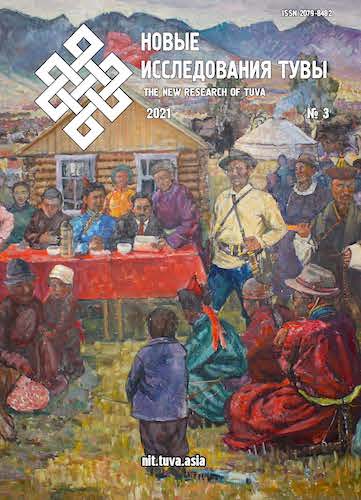«The arshin first, the bayonet follows”: the transformation of ethnocultural landscape in 19th and early 20th century Tuva
DOI:
https://doi.org/10.25178/nit.2021.3.4Keywords:
Tuva; ethnocultural landscape; confessional space; Old Believers; Tuvans; Russians in Tuva; ethnic boundary; mutual representation; ethnoconfessional groupAbstract
The article examines the main tendencies of building a new ethnocultural landscape in Tuva during the 19th and early 20th century – a process seen through the lens of Russian-Tuvan interrelations, with Old Believers acting as pioneers. The author looks at their confessional migrations and the influence their household economy had on the construction of Tuva’s ethnocultural communities. The widely known fact that Old Believers played the key role in the intercultural exchange between newly-arrived Russians and aboriginal Tuvans can be proved by analyzing traditions, various forms of interaction, stereotypes, borrowings, exchanges and social connections which appear both externally and internally.
The article also provides new details of how Russian settlers first appeared in Tuva, founded new settlements of their own and built relations with the local population. This helped us trace the major trajectories for preserving and developing traditional culture of the Russians within the general context of the region’s ethnoconfessional history. The author examines these processes in the light of unpublished memoirs by Russian old-timers, published materials of Tuvan folklore, evidence from foreign travelers, officials and scholars, and of field materials collected by the author.
Versions of mutual representations by ethnoconfessional groups are examined here in the context of their sustainability as theorized by Fredrik Barth – given the fact that cultural difference can be preserved even despite interethnic contacts and interrelations. For the first time, the article provides the notions of the “own” vs “alien” in the ethnocultural world view which appear in folklore materials and oral narratives.
References
Balakina, G. F. and Anaiban Z. V. (1995) Sovremennaia Tuva: sotsiokul'turnye i etnicheskie protsessy [Contemporary Tuva: socio-cultural and ethnic processes]. Novosibirsk, Nauka, Sib. izd. firma. 137 p. (In Russ.).
Balakina, G. F. (1998) Dinamika sotsiokul'turnykh realii v period transformatsii [Dynamics of socio-cultural realities in the period of transformation]. In: Sotsial'no-ekonomicheskie problemy Respubliki Tyva v period transformatsii [Socio-economic problems of the Republic of Tyva in the period of transformation]: a collection of research articles / ed. by G. F. Balakina. Novosibirsk, Izd-vo SO RAN. 120 p. Pp. 75–84. (In Russ.).
Barth, F. (2006) Vvedenie [Introduction]. In: Etnicheskie gruppy i sotsial'nye granitsy. Sotsial'naia organizatsiia kul'turnykh razlichii [Ethnic groups and social boundaries. The social organization of cultural differences] / ed. by Fredrik Barth. Moscow, Novoe izdatel'stvo. 200 p. Pp. 9–49. (In Russ.).
Belova, O. V. (2005) Etnokul'turnye stereotipy v slavianskoi narodnoi traditsii [Ethnocultural stereotypes in the Slavic folk tradition]. Moscow, Indrik. 288 p. (In Russ.).
Dulov, V. I. (1956) Sotsial'no-ekonomicheskaia istoriia Tuvy. XIX — nachalo XX v. [The socio-economic history of Tuva: 19th — early 20th centuries]. Moscow, Publishing House of the Academy of Sciences of the USSR. 608 p. (In Russ.).
Istoriia Tuvy [The History Of Tuva] (2001) : in 2 vol. 2nd ed / ed. by S. I. Vanshtein and M. Kh. Mannai-ool. Novosibirsk, Nauka. Vol. I. 367 p. (In Russ.).
Katanov, N. F. (2011) Ocherki uriankhaiskoi zemli. Dnevnik puteshestviia, ispolnennogo v 1889 godu [Essays on the Uriankhai Territory. The diary of a journey made in 1889]. Prep., introduction and comm. by A. K. Kuzhuget. Kyzyl, TIGPI pri Pravitel'stve RT. 383 p. (In Russ.).
Kon, F. Ya. (2007) Usinskii krai [Usinskii region]. In: Uriankhai. Tyva depter [Uriankhai. A Tuvan notebook] / comp. by S. K. Shoigu. Moscow, Slovo. Vol. 4. Uriankhaiskii krai: perekrestok mnenii (konets XIX — nachalo XX v.) [Uriankhai Territory: the intersection of opinions (late 19th — early 20th century)]. 549 p. Pp. 262–347. (In Russ.).
Kon, F. Ya. (2007) Ekspeditsiia v Soiotiiu [An Expedition to Soyotia]. In: Uriankhai. Tyva depter [Uriankhai. A Tuvan notebook] / comp. by S. K. Shoigu. Moscow, Slovo. Vol. 4. Uriankhaiskii krai: perekrestok mnenii (konets XIX — nachalo XX v.) [Uriankhai Territory: the intersection of opinions (late 19th — early 20th century)]. 549 p. Pp. 348–548. (In Russ.).
Kurbatskii, G. N. (2001) Tuvintsy v svoem fol'klore (istoriko-etnograficheskie aspekty tuvinskogo fol'klora) [Tuvans in their folklore: Historical and ethnographic aspects of Tuvan folklore)]. Kyzyl, Tuva book publishing house. 464 p. (In Russ.).
Lamazhaa, Ch. K. (2018) Natsional'nyi kharakter tuvintsev [National character of Tuvans]. Moscow, St. Petersburg, Nestor-Istoriia. 240 p. (In Russ.)
Maslov, P. P. (2007) Konets Uriankhaia. Putevye ocherki [The End of Uriankhai: Travel essays]. In: Uriankhai. Tyva depter [Uriankhai: A Tuvan Notebook]: in 7 vols. / comp. by S. K. Shoigu. Moscow, Slovo. Vol. 5. Uriankhaiskii krai: ot Uriankhaia k Tannu-Tuve (konets XIX — pervaia polovina XX v.) [Uriankhai Territory: from Uriankhai to Tannu-Tuva (late XIX — first half of XX century)]. 735 p. Pp. 618–729. (In Russ.).
Mamsik, T. S. (1982) Belovodtsy i Belovod'e (Po materialam sledstvennogo dela o pobege 1827–1828 gg.) [Belovodtsy and Belovodye (from the investigation of the case of great escape of 1827–1828)]. In: Istochniki po kul'ture i klassovoi bor'be feodal'nogo perioda (Arkheografiia i istochnikovedenie Sibiri) [Sources on culture and class struggle of the feudal period: Archeography and source studies of Siberia] / ed. by N. N. Pokrovsky and E. K. Romodanovskaia. Novosibirsk, Nauka. 273 p. Pp. 135–165. (In Russ.).
Pokrovsky, N. N. and Zol'nikova, N. D. (2002) Starovery-chasovennye na vostoke Rossii v XVIII–XX vv. : Problemy tvorchestva i obshchestvennogo soznaniia [Old believers of the Chasovennoye accord in the East of Russia in the 18th – 20th centuries: Problems of creativity and public consciousness]. Moscow, Pamiatniki istoricheskoi mysli. 471 p. (In Russ.).
Putilov, N. A. (1885) Usinskii krai [Usinskii region]. Eniseiskie eparkhial'nye vedomosti, no. 1, 5, 9, 12, 16, 19–20. (In Russ.)
Putilov, N. A. (1914) Letopis' Usinskoi missii, nakhodiashcheisia na reke Usu, Eniseiskoi gub., Minusinskogo okruga, Shushenskoi volosti, bliz kitaiskoi granitsy [The chronicle of the Usinskaia mission on the Us River, Yenisei Governorate, Minusinsky district, Shushenskaya volost, near the Chinese border]. In: Sibirskii arkhiv [Siberian Archive]: Journal of History, Archeology, Geography and Ethnography of Siberia, Central Asia and the Far East, no. 1, January, pp. 27–40. (In Russ.)
Radlov, V. V. (1907) Obraztsy narodnoi literatury tiurkskikh plemen [Samples of folk literature of the Turkic tribes]. Part IX. Dialects of the Uriankhai (Soyots), Abakan Tatars and Karagases. Texts collected and translated by N. F. Katanov. St. Petersburg, s. n. 659 p. Pp. 1–216. (In Russ.)
Rodevich, V. M. (2007) Ocherk Uriankhaiskogo kraia [An outline of the Uriankhai Territory]. In: Uriankhai. Tyva depter [Uriankhai. Tyva depter] : in 7 vols. / comp. by S. K. Shoigu. Moscow, Slovo. Vol. 3: Uriankhaiskii krai. Tuvinsko-russkie otnosheniia (nachalo XVII — nachalo XX vv.) [Uriankhai Territory. Tuvan-Russian relations (early 17th — early 20th centuries)]. 608 p. Pp. 342–542. (In Russ.).
Rygovskii, D. S. (2018) «Pravilo chashki»: gostepriimstvo staroobriadtsev v antropologicheskoi perspektive [“The rule of the cup”: the hospitality of the Old Believers in an anthropological perspective]. In: IV Tsentral'noaziatskie istoricheskie chteniia. Prostranstvo kul'tur: cherez prizmu edinstva i mnogoobraziia [4th Readings in Central Asian history: The space of cultures through the prism of unity and diversity]: Proceedings of an international conference / ed. by Z. Yu. Dorzhu, V. M. Damdynchap, Yu. V. Popkova and A. A. Storozhenko. Kyzyl, TuvSU Publ. 350 p. Pp. 172–177. (In Russ.)
Storozhenko, A. A. (2015) Konfessional'nye migratsii staroobriadtsev kak kanal mezhkul'turnogo vzaimodeistviia v Tsentral'noi Azii v XIX — nachale XX v. [Confessional migrations of Old Believers as a channel of intercultural interaction in Central Asia in the 19th — early 20th centuries]. In: Staroobriadchestvo: istoriia i sovremennost', mestnye traditsii, russkie i zarubezhnye sviazi [Old Belief: history, modernity and local traditions, Russian and foreign relations]: Proceedings of the 6th International research and practical conference / ed. by A. P. Maiorov and S. V. Vasil'eva. Ulan-Ude, Izd-vo Buriatskogo gos. un-ta. 392 p. Pp. 130–136. (In Russ.).
Storozhenko, A. A. (2019a) Staroobriadcheskie monastyri «eniseiskogo meridiana» v XX veke: istoki, traditsii i sovremennoe sostoianie [Old Belief monasteries of the «Yenisei meridian» in the 20th century: origins, traditions and current state]. New Research of Tuva, no. 1, pp. 4–15. (In Russ.). DOI: https://www.doi.org/10.25178/nit.2019.1.1
Storozhenko, A. A. (2019b) S Volgi na Enisei v XIX veke: istoriia odnogo udachnogo pereseleniia staroobriadcheskogo klana [From the Volga to the Yenisei river in the nineteenth century: a story of a successful resettlement of an Old Believer clan]. In: Knizhnost' i staroobriadchestvo Kostromskogo kraia i sopredel'nykh territorii [Book culture and the old believers of Kostroma region and adjacent territories] : a collection of research articles / ed. by Yu. S. Beliankin. Moscow, Arkheodoksiia. Vol. 2. 140 p. Pp. 132–139. (In Russ.).
Tatarintseva, M. P. (2006) Staroobriadtsy v Tuve: istoriko-etnograficheskii ocherk [Old Believers in Tuva: a historical and ethnographic essay]. Novosibirsk, Nauka. 216 p. (In Russ.).
Tatarintseva, M. P. (2009) Chastushki. Russkii fol'klor v Tuve [Chastushki. Russian folklore in Tuva]. Kyzyl, Anyiak. 200 p. (In Russ.).
Tatarintseva, M. P. (2018) Problema sokhraneniia kul'turnykh traditsii v izmeniaiushchikhsia usloviiakh (na primere staroobriadtsev v Tuve) [The problem of preserving cultural traditions in changing conditions: the case of Old Believers in Tuva)]. In: IV Tsentral'noaziatskie istoricheskie chteniia. Prostranstvo kul'tur: cherez prizmu edinstva i raznoobraziia [4th readings in Central Asian history: The space of cultures through the prism of unity and diversity]. Proceedings of an international conference / ed. by Z. Yu. Dorzhu, V. M. Damdynchap, Yu. V. Popkova and A. A. Storozhenko. Kyzyl, TuvSU Publ. 350 p. Pp. 177–181. (In Russ.).
Tatarintseva, M. P. and Mollerov, N. M. (2016) Russkie v Tuve (konets XIX — pervaia polovina XX v.) [Russians in Tuva in late 19th and the first half of 20th centuries]. Novosibirsk, Nauka. 295 p. (In Russ.).
Published
How to Cite
For citation:
Storozhenko A. A. «Arshin vperedi, a shtyk pozadi»: osobennosti skladyvaniia etnokul’turnogo landshafta Tuvy v XIX — nachale XX v. [«The arshin first, the bayonet follows”: the transformation of ethnocultural landscape in 19th and early 20th century Tuva]. New Research of Tuva, 2021, no. 3, pp. 49-60. DOI: https://www.doi.org/10.25178/nit.2021.3.4
Issue
Section

This work is licensed under a Creative Commons Attribution-NonCommercial 4.0 International License.

Author(s) license holder(s) grant rights for their work to the journal (grantee of a license) under the simple non-exclusive open license in accordance with Art. 1286.1 «Open license for a research work, work of literature or fine arts», Civil Code of the Russian Federation.
New Research of Tuva publishes articles under the Creative Commons Attribution-NonCommercial license (CC BY-NC).
Since it is an open license, author(s) reserve the right to upload the article to their institutional repository, submit it to another journal (if it allows republications), or republish it on their own website (in full, or in part).
However, several conditions apply here:
a) The republished version must always contain the name(s) and affiliation(s) of the author(s), the original title and the hyperlink to the original version on the New Research of Tuva website;
b) It must be in open access, free of charge, and no category of readers must be in any way whatsoever advantaged over general readership.
c) should the contribution be submitted elsewhere by its author(s) without substantial modification (30% or more of original text unchanged), the body of the article should contain a disclaimer that the original version was published in New Research of Tuva (with a link to the respective page)
The CC-BY-NC is a non-revocable license which applies worldwide and lasts for the duration of the work’s copyright.









